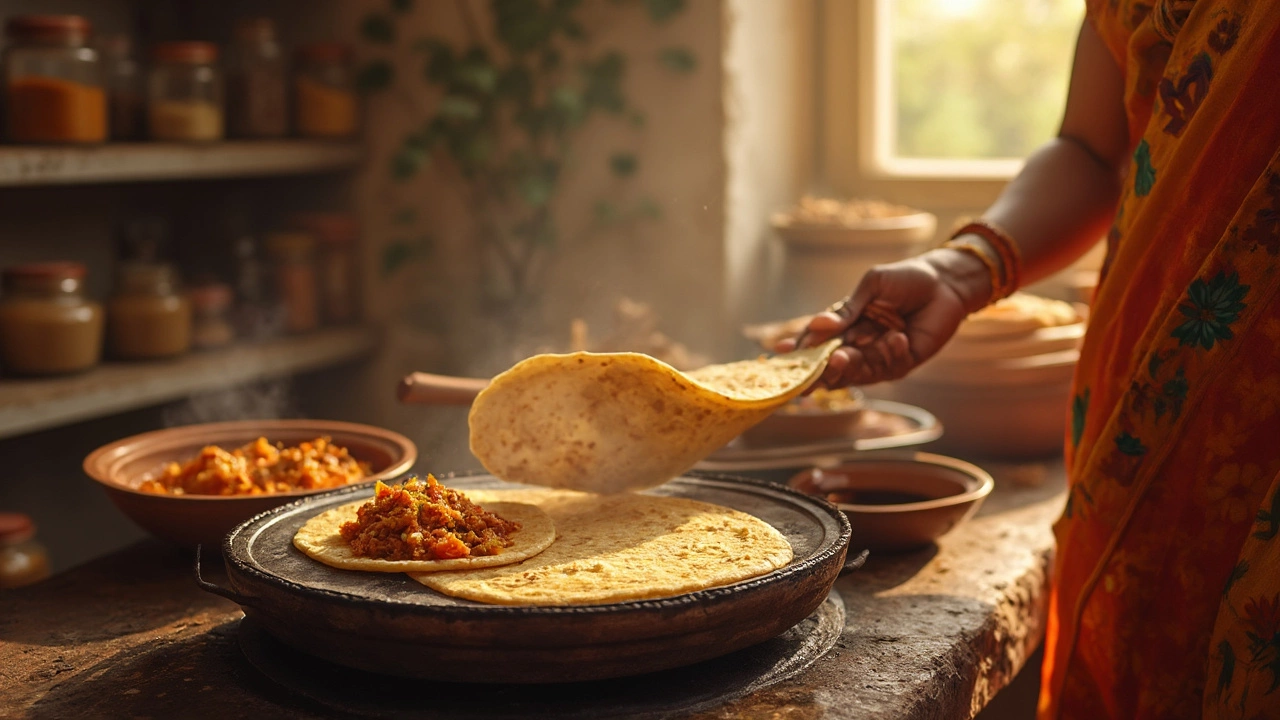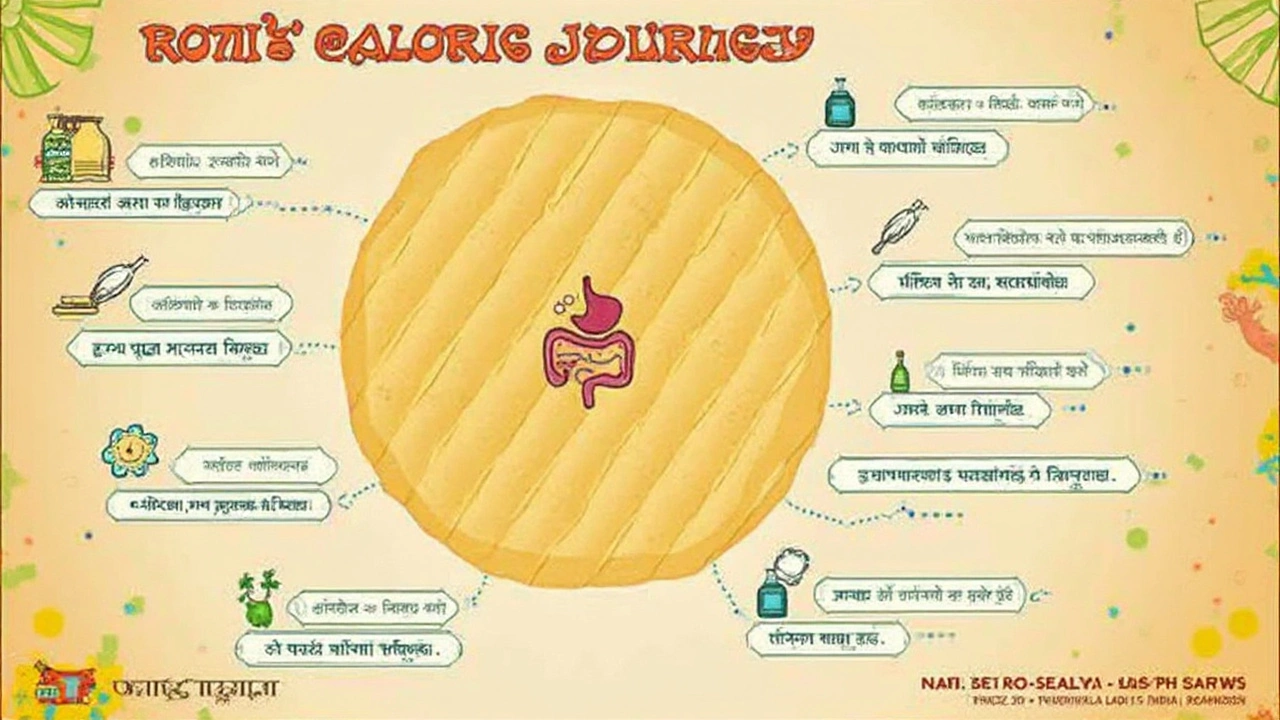Understanding How Your Body Processes Calories in Roti
 Feb, 25 2025
Feb, 25 2025
When asking yourself how much calories in 1 roti?, it's not just a casual curiosity but a key step to understanding your diet. An average roti can clock in at about 70-80 calories, depending on its size and thickness. Add some sabzi, and you're looking at roughly 200 calories for a wholesome meal. If you love a roti with a drizzle of ghee, it’ll bump up the calories a bit more, bringing you somewhere around 120 calories for that tasty treat.
Knowing these numbers is crucial if you're aiming to monitor your intake. But calories in 1 roti and sabzi aren't the villains here. They’re the energy that fuels your daily activities. In fact, roti, a staple in many South Asian diets, is packed with carbohydrates that are your body's primary source of energy. But let's make it clear: not all calories are created equal.
The way your body processes these calories depends on various factors. Ever noticed how some people can eat way more and still remain slim while others seem to gain weight more easily? Your metabolic rate and lifestyle play huge roles here. The key is to balance your calorie intake with your energy expenditure - basically, move more, eat mindfully, and choose nutrition-packed foods when possible. Let's look at some tips on integrating roti into your balanced diet while keeping track of how many calories in 1 roti make it onto your plate.
- Calorie Breakdown in Roti
- How Your Body Metabolizes Roti
- Roti in a Balanced Diet
- Tips for Healthier Roti Consumption
Calorie Breakdown in Roti
Understanding the calories in roti is a game-changer if you're keeping tabs on your diet. Let's break it down in simpler terms. A plain roti, which is a flatbread commonly made from whole wheat flour, generally contains about 70-80 calories per piece. But hey, that's just the raw number - let's look a little deeper.
What's Inside Your Roti?
Depending on the ingredients and preparation, the calorie count can slightly shift. Here's how it generally breaks down:
- Carbohydrates: These are the heavy-lifters in roti, making up around 15-20 grams per piece, translating into energy that powers you through your day.
- Proteins: Adding a subtle but essential 2-3 grams, they play a crucial role in muscle maintenance and repair.
- Fats: Typically minimal in a basic roti, unless ghee is added, boosting the count with healthy fats.
Now, if you're slathering some butter or ghee on that roti, expect an additional 40-50 calories per teaspoon. And let's not forget, calories in 1 roti with ghee can be a delightful treat but also a calorie-heavy one.
Comparing Rotis
| Type of Roti | Calories |
|---|---|
| Plain Roti | 70-80 |
| Roti with Ghee | 110-130 |
| Roti with Sabzi | 150-250 (depends on sabzi) |
For those days when you're eyeing your calorie intake, pairing your roti with a healthy vegetable dish can load your meal with fiber, nutrients, and yes, calories in 1 roti and sabzi become part of the math.
How to Keep Your Roti Nutritious
- Portion Control: Keep your serving size in check. Opt for smaller rotis if you're counting calories.
- Whole Grains: Choose whole wheat or multi-grain rotis for more fiber and nutrients.
- Healthy Toppings: Be mindful with ghee or butter; try to limit or swap with a light spread of olive oil.
The trick is to enjoy your meals while being mindful of your intake. By understanding how many calories in 1 roti, it becomes easier to balance taste and nutrition effectively.
How Your Body Metabolizes Roti
Understanding how roti interacts with your body is crucial for those keeping track of the calories in roti. When you take a bite of your beloved roti, the metabolic journey begins right as it enters your mouth. Your saliva contains enzymes that start breaking down carbohydrates into simpler sugars. This process continues more vigorously in the stomach and small intestine.
The Role of Carbohydrates
Rotis are primarily made from whole grains, offering complex carbohydrates. This means they take longer to break down, helping you feel full for a longer time. It’s a slow release of energy, making it a perfect choice to kickstart your day or fuel an afternoon.
Where Calories Come Into Play
It's easy to wonder how many calories in 1 roti affect your diet. Once broken down, these carbohydrates are absorbed into the bloodstream as glucose. Here’s where your body's energy needs decide its fate: use it immediately, or store it. If you're active, your body will love this energy boost. If not used, it's less ideal as the excess may turn into fat.
Managing Your Calorie Intake
- Enjoy your roti but balance it with proteins like dal or chickpeas to keep hunger at bay.
- If you're walking, running, or working out, that's a great time to indulge—your body will thank you.
- There's nothing wrong with a roti with ghee now and then—it’s extra flavor and a treat! Just watch the portion size.
By understanding your calorie processing in roti, you can better tailor your meals to fit your lifestyle, making meal prepping simpler. This approach not only supports maintaining a healthy weight but promotes overall well-being. Remember, our metabolic pathways are like finely tuned instruments—let them harmonize with your diet!

Roti in a Balanced Diet
Finding balance in your diet isn’t about cutting out foods you love, it's about making smarter choices. Roti, being a staple, fits perfectly into a balanced diet when combined with the right nutrients.
Why Include Roti?
First off, let's look at why roti deserves a spot on your plate. It provides carbohydrates, essential for your body's energy, alongside a fair amount of fiber, crucial for good digestion. If we consider adding a calories in 1 roti approach to our daily intake, we can enjoy meals without overindulgence.
"Whole grain foods, like whole wheat roti, supply valuable nutrients that support a healthier lifestyle," says Dr. Priya Singh, a renowned nutritionist.
Steps to Balance Roti in Your Diet
- Portion Control: Keep an eye on how many roti you're having. A general rule is to balance it out with ample vegetables and protein.
- Pair Wisely: Pair your roti with high-protein foods like lentils or chickpeas. This combination keeps you full longer and provides essential amino acids alongside your calories in roti.
- Choose Whole Wheat: Opt for whole wheat roti instead of refined flour. Whole grains have more fiber and nutrients, aiding digestion and keeping energy levels stable.
- Avoid Excess Ghee: While calories in 1 roti with ghee might add flavor, use it sparingly to prevent extra calorie load.
Practical Tip
Always start with a serving of salad or vegetables before diving into your meal. It helps in cutting down the urge to overeat the higher calorie items.
By incorporating these small changes, you can enjoy the humble roti without any guilt and in a manner that supports an overall balanced diet. What's important is understanding that every meal is an opportunity to fuel your body in the right way.
Tips for Healthier Roti Consumption
Eating roti can be part of a healthy diet, but making a few simple tweaks can elevate its nutritional profile even further. Let's look at some practical ways to enjoy your favorite flatbread while keeping an eye out for the calories in roti!
1. Choose Whole Grains
Opting for whole wheat or multigrain roti can make a big difference. Whole grains are packed with fiber, which gives you more bang for your buck and helps you feel full longer. It's a great way to enjoy the same number of calories in 1 roti, but with added benefits.
2. Watch the Add-ons
Adding ghee is delicious, but it can quickly increase the calorie count in your roti with ghee. If you can't skip it, try using a small amount or switch to healthier alternatives like olive oil or skipping it every now and then. This ensures you keep an eye on how much calories in 1 roti you're consuming.
3. Portion Control
Ever notice how easy it is to munch through multiple rotis in one sitting? Try serving yourself one or two and see if you're genuinely still hungry before grabbing another. Pairing your roti with protein-rich sides like lentils or a simple roti and sabzi can help, as they make meals more filling.
4. Try Rotating Flours
Using different flours like chickpea or sorghum occasionally can add variety and nutrients. Each type of flour has its own unique set of vitamins and provides a different texture and taste.
5. Be Mindful of Cooking Methods
Cooking your roti on a non-stick pan can help reduce the need for oil. You could also consider baking your rotis as a healthier alternative. Experiment and see what suits your taste without adding extra calories.
By making these small changes, you'll be better equipped to maintain a healthy balance, knowing exactly how many calories in 1 roti you're dealing with, while still enjoying every bite!